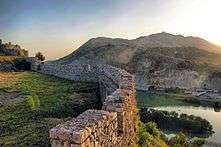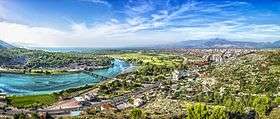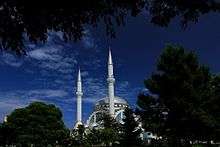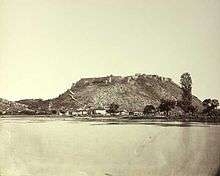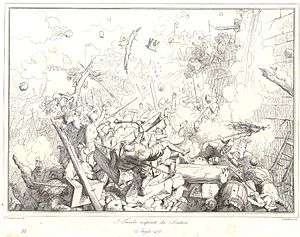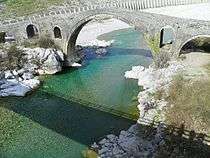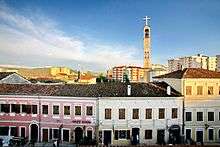Shkodër
| Shkodër | |||||||||
|---|---|---|---|---|---|---|---|---|---|
| Municipality | |||||||||
Shkodra photomontage | |||||||||
| |||||||||
 Shkodër | |||||||||
| Coordinates: 42°04′N 19°30′E / 42.067°N 19.500°ECoordinates: 42°04′N 19°30′E / 42.067°N 19.500°E | |||||||||
| Country |
| ||||||||
| County | Shkodër | ||||||||
| Government | |||||||||
| • Mayor | Voltana Ademi (DP) | ||||||||
| Area | |||||||||
| • Municipality | 872.71 km2 (336.96 sq mi) | ||||||||
| Elevation | 13 m (43 ft) | ||||||||
| Population (2011) | |||||||||
| • Municipality | 135,612 | ||||||||
| • Municipality density | 160/km2 (400/sq mi) | ||||||||
| • Administrative Unit | 77,075 | ||||||||
| Time zone | CET (UTC+1) | ||||||||
| • Summer (DST) | CEST (UTC+2) | ||||||||
| Postal Code | 4001-4007 | ||||||||
| Area Code | (0)22 | ||||||||
| Vehicle registration | AL | ||||||||
| Website | Official Website | ||||||||
Shkodër ([ˈʃkɔdəɾ]; definite Albanian form: Shkodra [ˈʃkɔdɾa], for other names see the etymology section), is a city and municipality in northwestern Albania and the seat of the county with the same name. It is one of the oldest and most historic places in Albania and also in the Balkans, as well as an important cultural and economic centre. In ancient times, Shkodër was known under the name Scodra and was the capital of the Labeates, an old Illyrian tribe.
During many different epochs it has retained its status as a major city in the wider region, due to its geostrategic positioning close to the Adriatic and the Italian ports, but also with land-routes to other important cities and towns in neighbouring regions. The future Adriatic–Ionian motorway or Blue Corridor will be passing through Shkodër and continue south via Tiranë-Durrës-Gjirokastër.
The present municipality, which now extends from the Albanian Alps to the Adriatic Sea, was formed at the 2015 local government reform by the merger of the former municipalities Ana e Malit, Bërdicë, Dajç, Guri i Zi, Postribë, Pult, Rrethinat, Shalë, Shkodër, Shosh and Velipojë, that became municipal units. The seat of the municipality is the city Shkodër.[1] The total population is 135,612 (2011 census), in a total area of 872.71 km2.[2] The population of the former municipality at the 2011 census was 77,075.[3]
Its importance is heightened by the Lake of Skadar to the west of the city — the largest lake in Southern Europe — that straddles Albania and neighbouring Montenegro. The population of Shkodër municipality at the 2011 census was 77,075, while Shkodër County had a population of 215,347.[3]
History
Etymology
The name of Shkodra is first attested in antiquity in the form Skodra (Latin: Scodra, Ancient Greek: Σκόδρα),[4][5][6] and in the Greek genitive Σκοδρινῶν ('of the Skodrians') found on coins from the 2nd century BC.[7] Its ultimate origins are unknown.[4] The further development of the name has been a subject of discussion among linguists over the linguistic provenance of Albanians and the Albanian language. While Çabej[8] and Demiraj[9] treat the development from Skodra to modern Shkodra as evidence of regular development within Albanian, Matzinger[4] argues that it fails to display certain known phonological changes that would have to have happened if the name had been continually in use in (proto-)Albanian since pre-Roman times.
The name was adapted to Italian as Scutari; in this form it was also in wide use in English until the 20th century.[10] In Serbo-Croatian, Shkodër is known as Skadar (Скадар), and in Turkish as İşkodra.
Antiquity
The town was known as Scodra [11] (Latin: Scodra)[12] during antiquity, and was the capital of the first kingdom of the Illyrian tribe of the Ardiaei, since the middle of the 3rd century BC.[13] The town, was first mentioned during classical times as the site of the Illyrian Labeates, as well as the capital of the kingdom of King Gentius[14]- in which he minted coins - and that of Queen Teuta. In the year 168 BC, the city was captured by the Romans and it became an important trade and military route. The Romans colonized[15] the town. Scodra remained in the province of Illyricum, and later Dalmatia. By it 395 AD, it was part of the Diocese of Dacia, within Praevalitana.
Middle Ages
The dawn of the Middle Ages saw waves of Slavs arriving. De Administrando Imperio describes how Byzantine Emperor Heraclius (r. 610-641) gave the Serbs a territory in this region during the first half of the 7th century. The southernmost, maritime polity of the Serbian Principality, at Duklja, included the Shkodër region. After the death of Prince Časlav (r. 927-960), the state disintegrated, with Duklja retaining most of it.[16] Tsar Samuel of Bulgaria had by 997 conquered all of Thessaly, Epirus, Macedonia, and most of modern Albania.[16] In the early 11th century, Jovan Vladimir ruled Duklja amidst the war between Basil II and Samuel. Vladimir allegedly retreated into Koplik when Samuel invaded Duklja, and was subsequently forced to accept Bulgarian vassalage.Vladimir was later slewn by the Bulgarians. Shingjon (the feast of St. Jovan Vladimir) has since been celebrated by Albanian Orthodox Christians.[17]
In the 1030s, Stefan Vojislav from Travunia expelled the last strategos, and successfully defeated the Byzantines by 1042. Stefan Vojislav set up Shkodër as his capital.[18] Constantine Bodin accepted the crusaders of the Crusade of 1101 in Shkodër. After the dynastic struggles in the 12th century, Shkodër became part of the Nemanjić Zeta province. In 1330 Stephen Dečanski appointed his son Stephen Dušan as the governor of Zeta and its seat Shkodër (Serbian: Скадар).[19] In the same year Dušan and his father entered the conflict which resulted with campaign of Dečanski who destroyed Dušans court on Drimac river near Shkodër in January 1331. In April they made a truce,[20] but in August 1331 Dušan went from Shkodër to Nerodimlje and overthrew his father.[21]
During the fall of the Serbian Empire (14th century), Shkodër was taken by the Balšić family who surrendered the city to Venice in 1396, in order to form protection zone from the Ottoman Empire. During Venetian rule the city adopted the Statutes of Scutari, a civic law written in Venetian, which also contained Albanian elements such as Besa and Gjakmarrja.[22][23] Venetians built the St. Stephen's Church (later converted in the Fatih Sultan Mehmet Mosque by the Turks) and the Rozafa Castle. In 1478-79 Mehmed the conqueror laid siege on Shkodra.
In 1479 the city fell to the Ottomans and the defenders of the citadel emigrated to Venice, whereas many Albanians from the region retreated into the mountains.[12] Shkodra then became a seat of the newly established Ottoman sanjak, the Sanjak of Scutari.
In the Ottoman Empire
With two sieges (1474 and 1478-9) it became secure as an Ottoman territory. It became the centre of the sanjak and by 1485 there were 27 Muslim and 70 Christian hearths, although by the end of the next century there were more than 200 Muslim ones compared to the 27 Christian ones, respectively.[24]
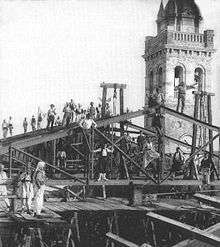
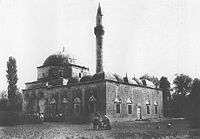
Military manoeuvres in 1478 by the Ottomans meant that the city was again entirely surrounded by Ottoman forces. Mehmed the Conqueror personally laid the siege. About ten heavy cannons were cast on site. Balls heavy as much as 380 kg (838 lb) were fired on the citadel (such balls are still on display on the castle museum). Nevertheless, the city resisted. Mehmet left the field and had his commanders continue the siege. By the winter the Ottomans had captured one after the other all adjacent castles: Lezhë, Drisht, and Žabljak Crnojevića. This, together with famine and constant bombardment lowered the morale of defenders. On the other hand, the Ottomans were already frustrated by the stubborn resistance. The castle is situated on a naturally protected hill and every attempted assault resulted in considerable casualties for the attackers. A truce became an option for both parties. On January 25 an agreement between the Venetians and the Ottoman Empire ended the siege, permitting the citizens to leave unharmed, and the Ottomans to take over the deserted city.

Shkodër was a major city under Ottoman rule in Southeast Europe. It retained its importance up until the end of the empire's rule in the Balkans in the early 20th century. This is due to its geo-strategic position that connects it directly with the Adriatic and with the Italian ports, but also with land-routes to the other important Ottoman centre, namely Prizren. The city was an important meeting place of diverse cultures from other parts of the Empire, as well as influences coming westwards, by Italian merchants. It was a centre of Islam in the region, producing many ulema, poets and administrators, particularly from the Bushati family.
In the 18th century Shkodër became the center of the (pashaluk) of Shkodër, under the rule of the Bushati family, which ruled from 1757 to 1831. Shkodër's importance as a trade center in the second half of the 19th century was owed to the fact that it was the center of the vilayet of Shkodër, and an important trading center for the entire Balkan peninsula. It had over 3,500 shops, and clothing, leather, tobacco, and gunpowder were some of the major products of Shkodër. A special administration was established to handle trade, a trade court, and a directorate of postage services with other countries. Other countries had opened consulates in Shkodër ever since 1718. Obot and Ulcinj served as ports for Shkodër, and later on Shëngjin (San Giovanni di Medua). The Jesuit seminar and the Franciscan committee were opened in the 19th century.
Before 1867 Shkodër (İşkodra) was a sanjak of Rumelia Eyalet in Ottoman Empire. In 1867, Shkodër sanjak merged with Skopje (Üsküp) sanjak and became Shkodër vilayet. Shkodër vilayet was split into Shkodër, Prizren and Dibra sanjaks. In 1877, Prizren passed to Kosovo vilayet and Debar passed to Monastir vilayet, while Durrës township became a sanjak. In 1878 Bar and Podgorica townships belonged to Montenegro. In 1900, Shkodër vilayet was split into Shkodër and Durrës sanjaks.
After Ottoman domination was secure, large number of the population fled. Around the 17th century, the city began to prosper and it became the center of the Sanjak of Scutari (sanjak was an Ottoman administrative unit smaller than a vilayet). It became the economic center of northern Albania, its craftsmen producing fabric, silk, arms, and silver artifacts. Construction included two-story stone houses, the bazaar, and the Central or Middle Bridge (Ura e Mesit) over the Kir river, built during the second half of the 18th century, over 100 metres (330 feet) long, with 13 arcs of stone, the largest one being 22 metres (72 feet) wide and 12 metres (39 feet) tall.
Era of Nationalism
Shkodër played an important role during the League of Prizren, the Albanian liberation movement. The people of Shkodër participated in battles to protect Albanian land. The branch of the League of Prizren for Shkodër, which had its own armed unit, fought for the protection of Plav, Gusinje, Hoti, and Gruda, and the war for the protection of Ulcinj. The Bushati Library, built during the 1840s, served as a center for the League of Prizren's branch for Shkodër. Many books were collected in libraries of Catholic missionaries working in Shkodër. Literary, cultural, and sports associations were formed, such as Bashkimi ("The Union") and Agimi ("The Dawn"). The first Albanian newspapers and publications printed in Albania came out of the printing press of Shkodër. The Marubi family of photographers began working in Shkodër, which left behind over 150,000 negatives from the period of the Albanian liberation movement, the rise of the Albanian flag in Vlorë, and life in Albanian towns during the end of the 19th and the beginning of the 20th century.
20th century

During the Balkan Wars, Shkodër went from one occupation to another, when the Ottomans were defeated by the Kingdom of Montenegro. The Ottoman forces led by Hasan Riza Pasha and Esad Pasha had resisted for seven months the surrounding of the town by Montenegrin forces and their Serbian allies. Esad (Hasan had previously been mysteriously killed by Esad Pasha Toptani in an ambush inside the town) finally surrendered to Montenegro in April 1913, after Montenegro suffered a high death toll with more than 10,000 casualties. Miss Edith Durham also notes the cruelties suffered at the hand of Montenegrins in the wake of October 1913: "Thousands of refugees arriving from Djakovo and neighbourhood. Victims of Montenegro. My position was indescribably painful, for I had no funds left, and women came to me crying: 'If you will not feed my child, throw it in the river. I cannot see it starve.'"[25] Montenegro was compelled to leave the city to the new country of Albania in May 1913, in accordance with the London Conference of Ambassadors.
During World War I, Montenegrin forces again occupied Shkodër on June 27, 1915. In January 1916, Shkodër was taken over by Austria-Hungary and was the center of the zone of their occupation. When the war ended on 11 November 1918, French forces occupied Shkodër as well as other regions with sizable Albanian populations. After World War I, the international military administration of Albania was temporarily located in Shkodër, and in March 1920, Shkodër was put under the administration of the national government of Tirana. In the second half of 1920, Shkodër resisted another threat, the military intervention of the forces of the Kingdom of Serbs, Croats and Slovenes.

Shkodër was the center of democratic movements of the years 1921–1924. The democratic opposition won the majority of votes for the Constitutional Assembly, and on May 31, 1924, the democratic forces took over the town and from Shkodër headed to Tirana. From 1924 to 1939, Shkodër had a slow industrial development, small factories that produced food, textile, and cement were opened.
From 43 of such in 1924, the number rose to 70 in 1938. In 1924, Shkodër had 20,000 inhabitants, the number grew to 29,000 in 1938.
Shkodër was the seat of a Catholic archbishopric and had a number of religious schools. The first laic school was opened here in 1913, and the State Gymnasium was opened in 1922. It was the center of many cultural associations. In sports Shkodër was the first city in Albania to constitute a sports association, the "Vllaznia" (brotherhood). Vllaznia is the oldest sport club in Albania.
During the early 1990s, Shkodër was once again a major center, this time of the democratic movement that finally brought to an end the communist regime established by Enver Hoxha. In the later 2000s (decade), the city experiences a rebirth as main streets are being paved, buildings painted and streets renamed. In December 2010, Shkodër and the surrounding region was hit by probably the worst flooding in the last 100 years.[26] In 2011, a new swing bridge over the Buna River was constructed, thus replacing the old bridge nearby.
Geography
Shkodër is the largest city in the north of Albania and is located on the east side of Lake Shkodër, on the southern part of the Mbishkodra plain, between the rivers Drini and Buna. The Lake Shkodër lies on the border of Albania and Montenegro. It is the largest lake in the Balkan Peninsula. It is named after the city of Shkodër in northern Albania. The Buna River connects the lake with the Adriatic Sea, and the Drin River provides a link with the Ohrid Lake.[27] The lake is a cryptodepression, filled by the river Morača and drained into the Adriatic by the 41 km (25 mi) long Buna, which forms the international border on the lower half of its length.
The lake has 48 fish species of which 15 are endemic. The best known are: bleak, eel, mullet, grasshoppers and others. Bleak is particularly interesting because it lives exclusively in the Skadar Lake. It is an indigenous species and in her honor every year. In combination with Crmnicko wine this fish represents the specialty of Lake Skadar.
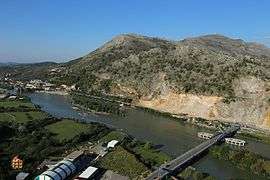 Buna River
Buna River Lake Shkodër
Lake Shkodër

Climate
Shkodër has a Mediterranean climate (Csa) that is almost wet enough in July to be a humid subtropical climate (Cfa); the average yearly temperature in the city varies from 14.5 °C (58.1 °F) to 16.8 °C (62.2 °F). The temperature in January ranges from 1.4 °C (34.5 °F) to 9.8 °C (49.6 °F); in August, from 19.3 °C (66.7 °F) to 32.4 °C (90.3 °F). The average yearly rainfall is about 1,700 millimetres (66.9 in), which makes the area one of the wettest in Europe.
| Climate data for Shkodra (1981-2010) | |||||||||||||
|---|---|---|---|---|---|---|---|---|---|---|---|---|---|
| Month | Jan | Feb | Mar | Apr | May | Jun | Jul | Aug | Sep | Oct | Nov | Dec | Year |
| Average high °C (°F) | 9.8 (49.6) |
11.0 (51.8) |
14.8 (58.6) |
18.5 (65.3) |
24.2 (75.6) |
28.1 (82.6) |
32.1 (89.8) |
32.4 (90.3) |
27.5 (81.5) |
21.7 (71.1) |
14.9 (58.8) |
10.5 (50.9) |
20.5 (68.9) |
| Daily mean °C (°F) | 5.6 (42.1) |
6.6 (43.9) |
10.1 (50.2) |
13.8 (56.8) |
18.7 (65.7) |
22.3 (72.1) |
25.4 (77.7) |
25.8 (78.4) |
21.5 (70.7) |
16.5 (61.7) |
10.6 (51.1) |
7.0 (44.6) |
15.3 (59.5) |
| Average low °C (°F) | 1.4 (34.5) |
2.1 (35.8) |
5.2 (41.4) |
9.0 (48.2) |
13.2 (55.8) |
16.5 (61.7) |
18.7 (65.7) |
19.3 (66.7) |
15.5 (59.9) |
11.2 (52.2) |
6.4 (43.5) |
3.4 (38.1) |
10.1 (50.2) |
| Average rainfall mm (inches) | 161.8 (6.37) |
159.0 (6.26) |
142.1 (5.594) |
147.6 (5.811) |
86.4 (3.402) |
50.6 (1.992) |
34.1 (1.343) |
58.2 (2.291) |
190.9 (7.516) |
206.6 (8.134) |
229.8 (9.047) |
211.1 (8.311) |
1,678.2 (66.071) |
| Average rainy days (≥ 1.0 mm) | 9 | 9 | 9 | 9 | 7 | 5 | 2 | 4 | 6 | 9 | 11 | 12 | 92 |
| Source: meteo-climat-bzh [28] | |||||||||||||
Economy
The main activities of the processing industry in Shkodra were the processing of tobacco and manufacture of cigarettes, production of conserved foods, sugar - based foods, soft and alcoholic drinks, and pasta, bread, rice and vegetable oil. The main activities of the textile industry were focused on garments and silk products. The city also had a wood-processing and paper-production plant. The most important mechanical engineering industries concerned wire manufacturing, elevator manufacturing, bus assembly and the Drini Plant.[29]
According to the World Bank, Shkodër has made significant steps of starting a business in 2016. Shkodër ranks 8[30] among 22 cities in Southeastern Europe before the capital Tirana, Belgrade, Serbia and Sarajevo, Bosnia and Herzegovina.
Transport
The SH1 is the main road connection between the Albanian capital, Tirana and Montenegrin capital Podgorica. SH1 leads to the Albanian - Montenegrin border at Hani i Hotit border crossing. From Tirana at the Kamza Bypass northward, it passes through Fushë-Kruja, Milot, Lezha, Shkodra, and Koplik. The road segment between Hani i Hotit at the Montenegrin border and Shkodra was completed in 2013 as a single carriageway standard. Shkodër Bypass started after the 2010 Albania floods. It was planned to incorporate a defensive dam against Shkodër Lake but works were abandoned a few years later. The road continues as a single carriageway down to Milot and contains some uncontrolled and dangerous entry and exit points. The SH5 starts from Shkodër to Morinë.
Culture
Shkodër is an important educational and industrial center. The city produces various mechanical and electrical components, along with textile and food products. Luigj Gurakuqi University of Shkodër is one of the more prestigious learning centers of Albania. The public library of the city contains more than 250,000 books. Other cultural institutions include the Cultural Center, the Marubi Photo Archives, the Artists and Writers Association, the Migjeni Theatre (named after Millosh Gjergj Nikolla), the Gallery of Arts and the Museum of History. Historic cultural architecture includes the Castle of Shkodër, the Turkish Bath, and the Lead Mosque. The Castle of Shkodër became famous during the First Balkan War when it was protected by the Turkish general Hasan Riza Pasha and Esad Pasha. Many festivals take place on an annual basis such as Carnival, Children Festival, Lake Day and Shkodra Jazz Fest.
Religion
The city of Shkodër was one of the most important centers for Islamic scholars and cultural and literary activity in Albania. Here stands the site of the only institution in Albania which provides high-level education in Arabic, Turkish and Islamic Studies.[31] Shkodër is the center of Roman Catholicism in Albania. Shkodër is also the episcous religpal see of the Metropolitan Roman Catholic Archdiocese of Shkodër-Pult (Scutari-Pulati) in the Shkodër Cathedral.
Music
City tunes differ from the rural music of the land, but both enjoy popularity in Shkodra. Northern music is a refined combination of romantic and sophisticated undertones with oriental-sounding scales and a constant interplay of major and minor. It bears a significant affinity with the sevdalinke of Bosnia, but differs from them in their extreme forms while maintaining a typically Albanian quality through the exceptional fluidity of rhythm and tempo. Early descriptions of such music groups, which date from the end of the 19th century, suggest use of the violin, clarinet, saze, defi, and sometimes Indian-style harmonium and percussion (provided by rattling a stick between two bottles). Today, the accordion and guitar have replaced the more exotic instruments. Among the most important players are Bik Ndoja, Luçije Miloti, Xhevdet Hafizi and Bujar Qamili.
Sights
The city and the surrounding area are blessed with a large variety of natural and cultural elements. The most attractive quarters of the city are commonly thought to be Pjaca, identifiable as the main city centre between statues of Mother Teresa and Luigj Gurakuqi, and Gjuhadol, the neighborhood around one of the most scenic streets connecting the Cathedral on the east side of town with the middle of the city. The most recognizable memorial is the legendary castle of Rozafa known also as Rozafati.
Lake of Shkodër is the biggest lake of the Balkans peninsula. It is a major summer attraction for tourists and inhabitants. Another interesting historical site is the ruins of Shurdhah (Sarda), a medieval town situated only 15 kilometres (9 miles) from Shkodër. To go out there you must take a motor-boat from the dam of Vau i Dejës out to the island where Shurdhah is located (about 10 miles, or 16 km). Shurdhah was built atop a hill on the island, roughly 5 ha in area, surrounded by the waters of the Drini river (which has been rerouted now to form an artificial lake). At one time it was the summer retreat of the famous Dukagjini Family. About 5 km (3 mi) east of Shkodër lies the medieval citadel of Drisht.
Many visitors feel that Shkodër is the soul of Albania. The very characteristic appearance of the city is formed by the juxtaposition of ancient houses and narrow streets joined with stone walls and modern buildings. After World War II, some of Shkodër was rebuilt with wider streets to accommodate automotive traffic, and new residential buildings are being constructed all the time.
Monuments
- Rozafa Castle due to its strategic location, the hill has been settled since antiquity. It was an Illyrian stronghold.
- Mes Bridge was built in the 18th century and is 108 m long and represent one of the longest Ottoman bridges in the region.
- Lead Mosque was built in 1773. It took the name Lead Mosque, because all of its cupolas were covered with lead.
- Ebu Beker Mosque was historically important in the scholarly learning of the city and attracted notable Islamic scholars and theologians.
- Shkodër Cathedral also known as St Stephen's Catholic Cathedral is dedicated to Saint Stephen.
- Shkodër Orthodox Cathedral is a modern orthodox cathedral also in the city of Shkodër.
- Kratul was an Illyrian settlement and fortification located in the territories of the Illyrian tribe of Labeates. The archaeological material indicates that life at the settlement was active from the early Iron Age (beginning of 1st millennium BC) until the 1st century AD.
- Shirgj Church is a ruined former Benedictine monastery in the village of Shirgj on the Bojana River and was built in 1290.
See also
- History of Albania
- Culture of Albania
- Albanian Alps
- Tourism in Albania
- List of ancient cities in Illyria
International relations
Twin towns – Sister cities
Shkodër is twinned with:
 - Skopje, Macedonia
- Skopje, Macedonia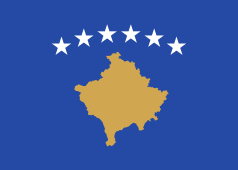 - Prizren, Kosovo
- Prizren, Kosovo – Ulcinj (Albanian: Ulqin), Montenegro
– Ulcinj (Albanian: Ulqin), Montenegro - Gjakova, Kosovo
- Gjakova, Kosovo - Cetinje, Montenegro
- Cetinje, Montenegro
Notable people
Below are some of the most notable personalities born or long time residents in Shkodër:
- Fahrettin Altay, Hero of Turkish War of Independence, comrade of Mustafa Kemal Atatürk
- Marin Barleti, 15th century Albanian historian and priest
- Marin Beçikemi, 15th century Albanian philosopher, orator, and professor
- Elhaida Dani, The Voice of Italy winner and Albanian Eurovision representative
- Gjergj Fishta, Albanian Catholic poet
- Simon Gjoni, composer
- Karl Gurakuqi, linguist and folklorist.
- Luigj Gurakuqi, one of the leaders of the Albanian national movement
- Kolë Idromeno, Albanian painter and photographer
- Prenkë Jakova, author of the first Albanian opera.
- Zef Jubani, folklorist and activist of the Albanian National Awakening
- Branko Kadija, communist, People's Hero of Albania
- Palokë Kurti, footballer, athlete, sports organizer, and sports journalist
- Tinka Kurti, famous Albanian actress
- Vojo Kushi, Albanian World War II hero and People's Hero of Albania
- Jordan Misja, communist, People's Hero of Albania
- Vioresin Sinani, legend footballer
- Henrik Lacaj, translator and scholar
- Zef Coba, composer
- Ndre Mjeda, Albanian Catholic romantic poet
- Hilë Mosi, Albanian politician and poet
- Ndoc Nikaj, Catholic priest, historian and writer
- Millosh Gjergj Nikolla, poet (pen name Migjeni)
- Erkand Qerimaj, world champion of weightlifting
- Gjergj Radovani, Bishop of Shkodër and later Archbishop of Bar
- Perlat Rexhepi, communist, People's Hero of Albania
- Filip Shiroka, Albanian renaissance poet
- Hodo Sokoli, leader of the League of Prizren
- Ramadan Sokoli, prominent ethnomusicologist
- Andrea Suma, Bishop of the Roman Catholic Diocese of Lezhë
- Ibrahim Tukiqi, Albanian singer.
- Lazër Vladanji, Archbishop of the Roman Catholic Archdiocese of Bar in the 18th century
- Gjergj Vladanji, Bishop of the Roman Catholic Diocese of Sapë in the 18th century
- Çesk Zadeja, composer
- Angela Martini, model and former Miss Universe Albania
- Irhan Jubica, writer and publisher
- Armando Vajushi, footballer
- Muhammad Nasiruddin al-Albani, Albanian Islamic scholar
Annotations
Notes:
| a. | ^ Kosovo is the subject of a territorial dispute between the Republic of Kosovo and the Republic of Serbia. The Republic of Kosovo unilaterally declared independence on 17 February 2008, but Serbia continues to claim it as part of its own sovereign territory. The two governments began to normalise relations in 2013, as part of the Brussels Agreement. Kosovo has received recognition as an independent state from 110 out of 193 United Nations member states. |
References
- ↑ Law nr. 115/2014
- ↑ Interactive map administrative territorial reform
- 1 2 2011 census results
- 1 2 3 Matzinger, Joachim (2009). "Die Albaner als Nachkommen der Illyrer aus der Sicht der historischen Sprachwissenschaft". In Schmitt, Oliver Jens; Frantz, Eva Anne. Albanische Geschichte: Stand und Perspektiven der Forschung. Munich: Oldenbourg. pp. 22–24.
- ↑ Krahe, Hans (1925). Die alten balkanillyrischen geographischen Namen auf Grund von Autoren und Inschriften. Heidelberg. p. 36.
- ↑ e.g. Ptolemy, Geographia II.16.; Polybius, Histories, XXVII.8.
- ↑ Wilkes, John (1992). The Illyrians. pp. 177–179. ISBN 0-631-19807-5.
- ↑ Cabej, Eqrem (1974). "Die Frage nach dem Entstehungsgebiet der albanischen Sprache". Zeitschrift für Balkanologie. 1012: 7–32.; cited after Matzinger 2009.
- ↑ Demiraj, Shaban (1999). Prejardhja e shqiptarëve nën dritën e dëshmive të gjuhës shqipe. Tirana. pp. 143–144.; cited after Matzinger 2009.
- ↑ Encyclopædia Britannica, 11th edition (1911), "Scutari" article.
- ↑ Polybius
- ↑ Titus Livius
- ↑ Encyclopædia Britannica 2002 page 680
- ↑ The Illyrians by John Wilkes,ISBN 0-631-19807-5,1992,page 172,"...Gentius among the Labeates around Scodra/"
- ↑ The Illyrians by John Wilkes,page 213,"The list of Roman settlements includes some of the... Scodra..."
- 1 2 Fine 1991, p. 193
- ↑ Koti 2006, para. 1, 2
- ↑ Fine 1991, p. 206
- ↑ Miladin Stevanović; Vuk Branković (srpski velmoža.) (2004). Vuk Branković. Knjiga-komerc. p. 38. Retrieved 20 April 2013.
После битке код Велбужда млади краљ Душан, чији је углед знатно порастао, добио је од оца на управљање Зету са седиштем у Скадру.
- ↑ Jović, Momir (1994). Srbija i Rimokatolička crkva u srednjem veku. Bagdala. p. 102. Retrieved 21 December 2013.
Краљ је у јануару 1331. г. разорио Душанов двор на реци Дримац, код Скадра. Половином априла долази до примирја
- ↑ Nikolić, Dejan (1996). Svi vladari Srbije. Narodna biblioteka "Resavska škola". p. 102. Retrieved 21 December 2013.
Стефан Душан је августа 1331. крен- уо са својом војском из Скадра и дошао до Стефановог дворца у Неродимљу, где је изненадио оца. Краљ Стефан је једва успео да побегне из свог дворца у град Петрич у коме га је Душанова војска опколила
- ↑ Anamali, Skënder and Prifti, Kristaq. Historia e popullit shqiptar në katër vëllime. Botimet Toena, 2002, ISBN 99927-1-622-3 pp. 231-232
- ↑ Nadin, Lucia. Statuti di Scutari: della prima meta del secolo XIV con le addizioni fino al 1469 / Statutet e Shkodrës: në gjysmën e parë të shekullit XIV me shtesat deri më 1469. Tirana: Onufri, 2012.
- ↑ Clayer, Nathalie. " Is̲h̲ḳodra." Encyclopaedia of Islam, Second Edition. Brill Online , 2012. Reference. 2 January 2012 <http://referenceworks.brillonline.com/entries/encyclopaedia-of-islam-2/ishkodra-SIM_8713>
- ↑ Twenty Years of Balkan Tangle: M.Edith Durham
- ↑ "Nato joins Albania rescue effort after Balkan floods". BBC News. 6 December 2010.
- ↑ Pešić V. & Glöer P. (2013). "A new freshwater snail genus (Hydrobiidae, Gastropoda) from Montenegro, with a discussion on gastropod diversity and endemism in Skadar Lake". ZooKeys 281: 69-90. doi:10.3897/zookeys.281.4409
- ↑ "moyennes 1981/2010".
- ↑ http://siteresources.worldbank.org/INTLED/Resources/339650-1122490529659/Shkodra.pdf
- ↑ http://www.doingbusiness.org/Rankings/south-east-europe
- ↑ Norris, H. T (1993). Islam in the Balkans: Religion and Society Between Europe and the Arab World. Columbia, South Carolina: University of South Carolina Press. p. 76. ISBN 0 87249 977 4. Retrieved 2016-05-12.
Sources
- Fine, John Van Antwerp (1991). The Early Medieval Balkans: A Critical Survey from the Sixth to the Late Twelfth Century. Michigan: The University of Michigan Press. ISBN 0-472-08149-7.
- Koti, Isidor (2006). "Celebration of Saint John Vladimir in Elbasan". Orthodox Autocephalous Church of Albania. Archived from the original on 2011-07-16.
- Wilkes, John J. (1995). The Illyrians. Oxford, United Kingdom: Blackwell Publishing. ISBN 0-631-19807-5.
External links
| Wikimedia Commons has media related to Shkodër. |
| Wikivoyage has a travel guide for Shkodra. |
- Region Council of Shkoder
- Free iOS City App
- Official Muslim Organization
- Official Facebook page
- Minibus departure times in Shkodra
- Kisha Katolike Shkodër
- Municipality of Shkodra (Albanian)
- Regional Council of Shkodër (Albanian)
- History of Shkodër
- Shkodra Jazz Festival
- Shkodra Web Site - Portal
- Stenda elektronike e njoftimeve ne Shkoder
- ShkodraOnline.com
- Shkodër travel guide
